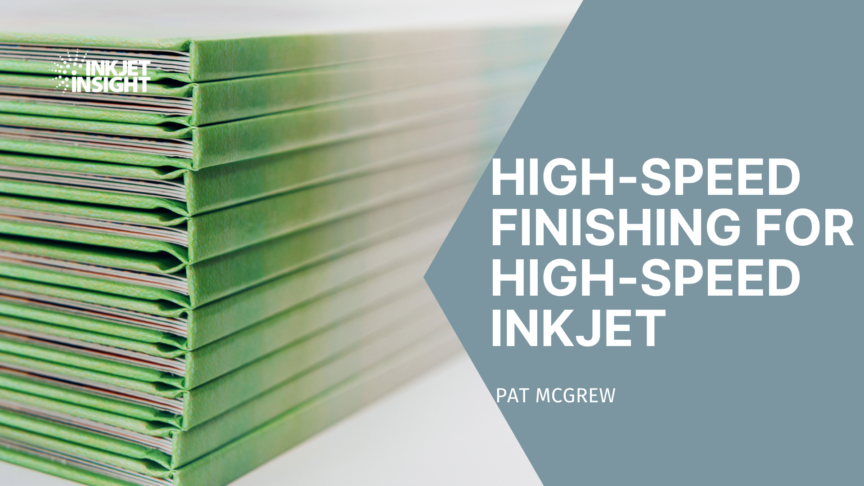Your inkjet press is a path to great capacity but getting products out the door is not only a function of how fast you can print. There is also the question of how to get from the printed sheet or roll to a finished product. Since inkjet devices support everything from transaction statements to books, catalogs, marketing collateral, and posters, the finishing processes demand speedy, versatile machines that help unlock the capacity of the press.
The good news is that it is 2022, and the finishing you need is available! While the press manufacturers were busy cranking up the speed on continuous presses and adding new cut-sheet devices, the finishing vendors went into overdrive. They added new unwind and rewind options, cutters, folders, stackers, perforators, stitchers, and wrappers, as well as full inline booklet makers and book manufacturing solutions.
Before you launch your expedition into the offerings, follow these steps to evaluate what you have:
- Find or build an equipment list that identifies each finishing device, its capabilities, age, maintenance requirements, and what products it supports.You may discover equipment that is rarely used, or equipment that creates a bottleneck. Add those notations and examples to your list.
- Review your investment in the devices. What did you pay for each device, and how long has it been in service? If you rent or lease, when did the agreement begin, and when does it terminate?
- Consider how well your finishing equipment is matched to your print devices? Use a metric that makes sense for your shop but be consistent. This is a metric you will want to track.
- Review the manual processes that happen between the end of printing and the start of finishing, as well as during finishing. Consider how often paper pallets are moved as they are worked or to get them out of the way.
Now you have data and information to guide your review of what options to consider!
Finding Finishing for Continuous-Feed Inkjet
Now it is time to talk to your current vendors and others in the market who may have solutions to add efficiency. Hunkeler, Horizon, and Tecnau bring decades of experience to digital finishing but they are not the only options. Also, look at the offerings from Contiweb, Kern, and BlueCrest, but don’t stop there. If you are a direct mailer or book printer, look at the Sprint offerings from VITS. If you want to upgrade your book finishing to sewn book blocks, the team at Meccanotecnica have interesting solutions. It will be worth your time to look at what they have to offer!
While you are looking, there are devices that you may not have considered that can improve your efficiency: a zero-speed splicer and turret unwind/rewind. If you are running a continuous feed device, you know that getting the next roll into production can be time-consuming. Perhaps you have done the exercise of timing how long it takes and comparing it to what your vendor told you to expect. The value proposition is that it can increase your uptime, reduce paper waste, and keep your high-speed press running at high speed by staging multiple rolls for print and having multiple take-up stations on the rewind. Hunkeler, Tecnau, and Contiweb have mature solutions for inkjet and can point to reference accounts that have achieved productivity gains from 20% to 40%, depending on the weight of the stock. (By the way – Inkjet Insight is launching some research into workflow automation for continuous inkjet – please contact us if you would like to be interviewed or just to learn more.)
Sundry Solutions for Sheet-Fed Inkjet
With more cut-sheet devices coming to market, the finishing vendors are paying attention. They have been supplying equipment that folds, creases, perfs, binds, die cuts, and inserts for decades, so they are ready. As you look at investing in or adding to your current group of cut-sheet inkjet presses, review your numbers to test your efficiency. Review your current finishing with your vendors. Look for a path to faster throughput and more finishing options.
As your print devices become faster, remember to keep your finishing solutions in step. If you invested in custom machinery for finishing, talk to your builder to understand your options for speed upgrades. Avoid making assumptions about what can and cannot be upgraded. Ask your vendors for help, and if they lack solution options, check with members of your peer groups, or send us a question!
The last guiding principle is ABCD. Always Be Capturing Data. We often focus on the press when we talk about shop floor data, but the finishing equipment should be part of that discussion. Understanding downtime, uptime, operator error, machine failure, and maintenance times will be critical to a happy finishing life.
Stay tuned for my next post where I look at ways to differentiate your options with finishing.

